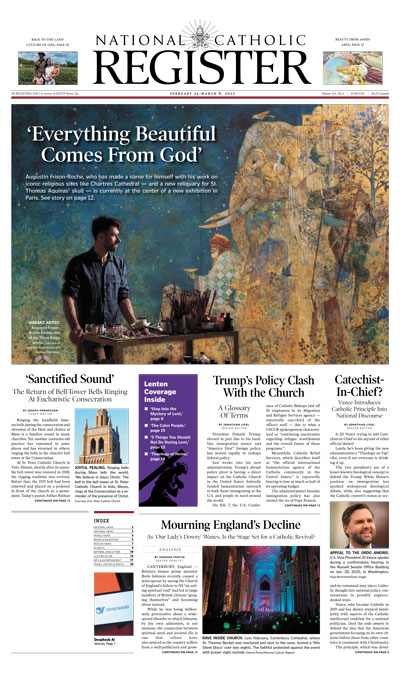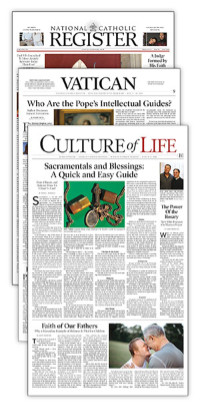Unlocking the Mystery of Jacob’s Ladder — and How It Points to Christ
OLD TESTAMENT & ART: Long before the Incarnation, Scripture gave us signs — and Jacob’s ladder is one of the clearest glimpses of the Word made flesh.

(Reading: Genesis 28)
Jacob is a most interesting patriarch. It is through him that God’s promise to Abraham would be realized. But he’s also a swindler.
I’ll admit my indebtedness to the Polish author, Roman Brandstaetter, whose novella Patriarchowie (The Patriarchs), is in large part a psychological and theological study of Jacob. Yair Zakovitch’s Jacob: Unexpected Patriarch pursues the same theme from a Jewish perspective.
Jacob is the one chosen by God to continue the Abrahamic covenant. That’s clear from God’s revelation to Rebekah (which he did not share with Isaac). But actions involve both the act and intention: while God may have chosen Jacob, he did not necessarily approve of Jacob’s “end justifies the means” tactics to swindle his brother. We’ll see how that plays out in Jacob’s life. We’ll also see how it burdens Jacob’s conscience.
When Esau returns home from the hunt to find his brother had cheated him out of his father’s blessing, things get dangerous and Rebekah (with Isaac’s concurrence, albeit so that he avoids a mixed marriage like Esau’s) sends Jacob off to her brother, Laban, for protection. En route, Jacob has an important vision.
Traveling all day, he laid himself down to rest as the sun was setting. The roughness of his situation is attested by Genesis: he lay on the ground and put a rock under his head for a pillow. Amid such comforts, he fell asleep.
In his dream, two important things happen. First, Jacob has a vision. He says he saw a “stairway” stretching between heaven and earth, on which angels were ascending and descending. (Some biblical scholars say the old term “ladder” is misleading.) He then hears God — “the God of Abraham, the God of Isaac” — promising him and his descendants this land, that God would protect Jacob, and that “I will never leave you until I have done what I promised you” (vv. 13-15).
Jacob then wakes up, realizes the place he stopped was holy ground (“the house of God, the gateway to heaven”), marks the place with an anointed stone, and names the place Beth-el (“house of God”).
Jacob’s “ladder” has long been an artistic inspiration, but it points to something far deeper. Just as Isaac on the sacrificial altar on Mount Moriah prefigures the future Christ, so, too, Jacob at Bethel points to the Incarnation. The “stairway” to heaven is neither a Led Zeppelin hit nor a variant on Michael Landon’s “highway” there. Indeed, it is not even a thing.
That “stairway” is Christ. It is he who spans heaven and earth. It is he who is incarnate in this world yet remains the eternal Son of the Father. It is he who remains incarnate in this world through the Eucharist yet sits at the right hand of the Father. It is he except through whom nobody comes to that Father (John 14:6). It is he who is the bridge between heaven and earth.
None of this, of course, may have entered Jacob’s mind: this vision is also prophetic. But what is already clear to him is that God does not sit in solitary splendor in some distant celestial realm but here, on this “stairway,” heaven and earth are in contact, God’s messengers doing his work.
God not only gives Jacob a vision but assures him. To a man whose conscience probably still gnawed, God assures he will not “leave” him. Not only will God shield him from exposure to his enemies — God will not just be a mark protecting Cain — but he will accomplish his plans in him, including giving him this land.
Jacob rightly recognized the place as a sanctuary and, in the usual Biblical pattern, renamed the place to correspond to its true identity: Beth-el, “house of God.” And, in testimony of that truth, Jacob anoints the rock and erects it as a marker of the encounter there between God and man. And Jacob, too, reciprocates — albeit with a trace of fear (with which love has no room — 1 John 4:18) — if God protects him, allows him to return there and to his father’s house, he pledges “the Lord will be my God” (v. 21) to whom he commits his tithe. He knows the precariousness of his situation.
He then got up and continued on his way to Uncle Laban.
As noted, Jacob’s dream was often the subject of artistic rendition. Today’s painting comes from Florence around 1577, but is held by the Walters Art Museum in Baltimore. Giorgio Vasari’s large oil painting (almost 7 by 8 feet) was thought to have been commissioned for a Florentine ceiling.
The painting depicts a stairway reaching from earth to heaven, along which angels process in both directions. Beneath the steps, on the darker earth, sleeps Jacob, his head supported by his hand supported by the rock. (Imagine falling asleep in that position?) In lighter, more ethereal realms, are the angels and God the Father (who also happens to be right above Jacob).
The Walters Museum commentator claims that the figures of God and of Jacob are copies of frescoes of those persons made by Michelangelo and Raphael. Vasari, who wrote a history of art in what we now call “Italy,” greatly respected those two artists, as signified by their incorporation into his work.
Jacob would eventually make his way back to his father’s home, but not without thoroughly atoning for his swindle. He will also return, as Brandstaetter notes, assured that “God is with him.” But that’s another story.
- Keywords:
- old testament & art
- jacob
- biblical typology

















